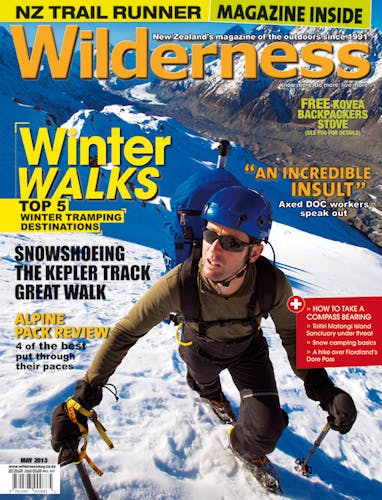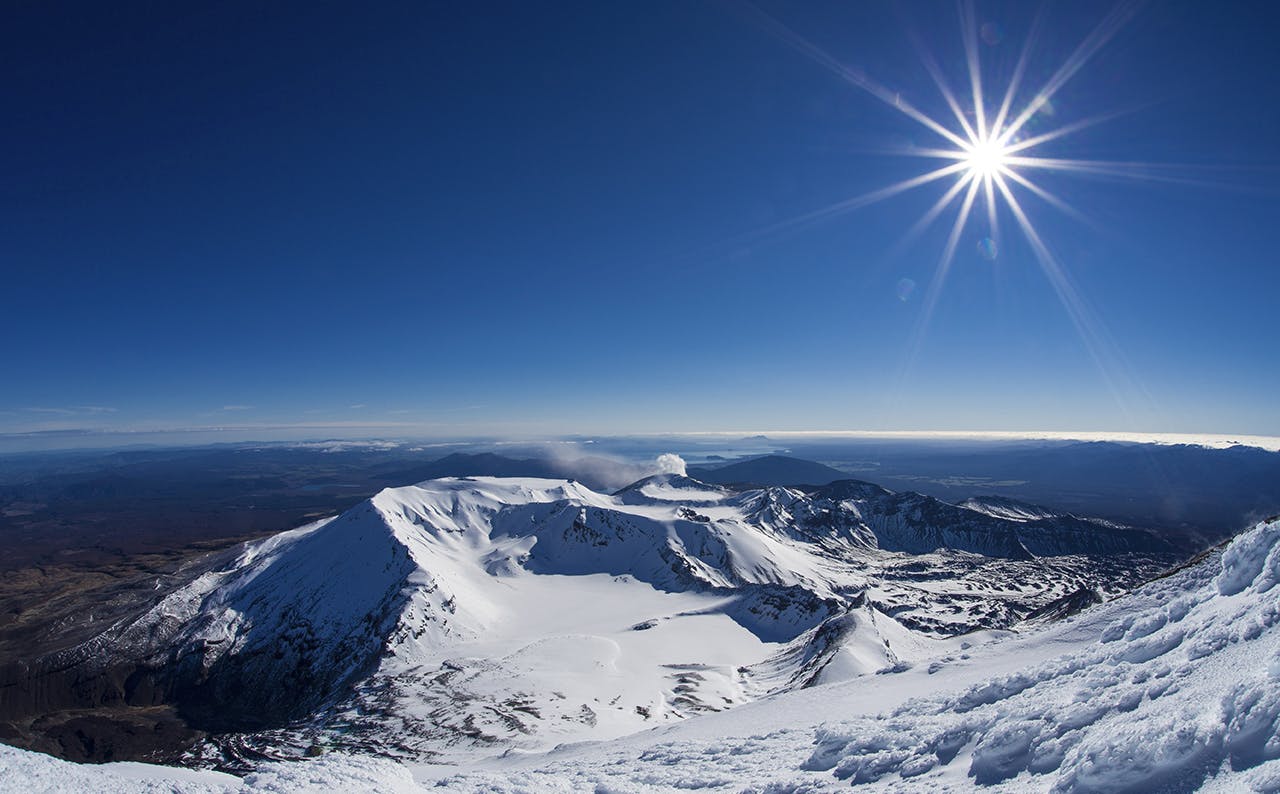Winter’s a special time to be in the mountains; there’re less people around, frost tickles the plants, the landscape becomes a pillowy white and the light takes on a special quality. Shorter days guarantee more sleeping time and if you’re really lucky you’ll cop a nice long fine spell.
Some of my more memorable trips into the ranges and volcanoes have been in winter. Although they’re not always memorable for the best reasons; I’ve been buried in my tent in the Remarkables and spent six hours wading out in thigh-deep snow – incredibly hard work even with snow shoes. Then there’s the frozen boots, the icy fingers and the added weight of winter survival kit. But these experiences are tempered by the countless stunning sunrises and sunsets and the solitude that comes with having a whole range to yourself in the dead of winter.
Following are some favourite winter tramping destinations, with some trip suggestions ranging from one to seven days.
Tongariro National Park
One of the world’s first national parks, Tongario is deservedly popular and consequently for much of the year it’s a busy place. Winter is a different story, though. While skiers flock to Ruapehu’s slopes, you can easily find some mountain solitude by walking Ruapehu’s classic Round the Mountain circuit, or by making a crossing of the park from the Desert Road via Waihohonu Hut, Outerere Hut, South Crater and the Mangatepopo Valley. This classic tramp passes through a wide variety of volcanic terrain and can be made all the more memorable with a side trip up the iconic lava cone of Mt Ngauruhoe.
One winter my partner and I arrived in Waiouru to find a thick blanket of snow over the whole park and the Desert Road closed. We hitchhiked to the Waihohonu Hut road end in a road inspection truck and headed into the park, ploughing fresh tracks through the snow. Icicles hung from large scoria boulders and when the sun set the whole park turned pink. For several days we had the eastern side of the mountains to ourselves and were lucky to witness the place on its own terms.
An ice axe and crampons are essential for the Waihohonu-Mangatepopo crossing, and for those without alpine skills the Ruapehu Round the Mountain trip is the best option. Either trip will show you a special side to one of our most unique national parks.
Access From the Desert Road, or, for the Round the Mountain, from the Whakapapa or Turoa ski field roads Time 5-7 days
Tararua Range
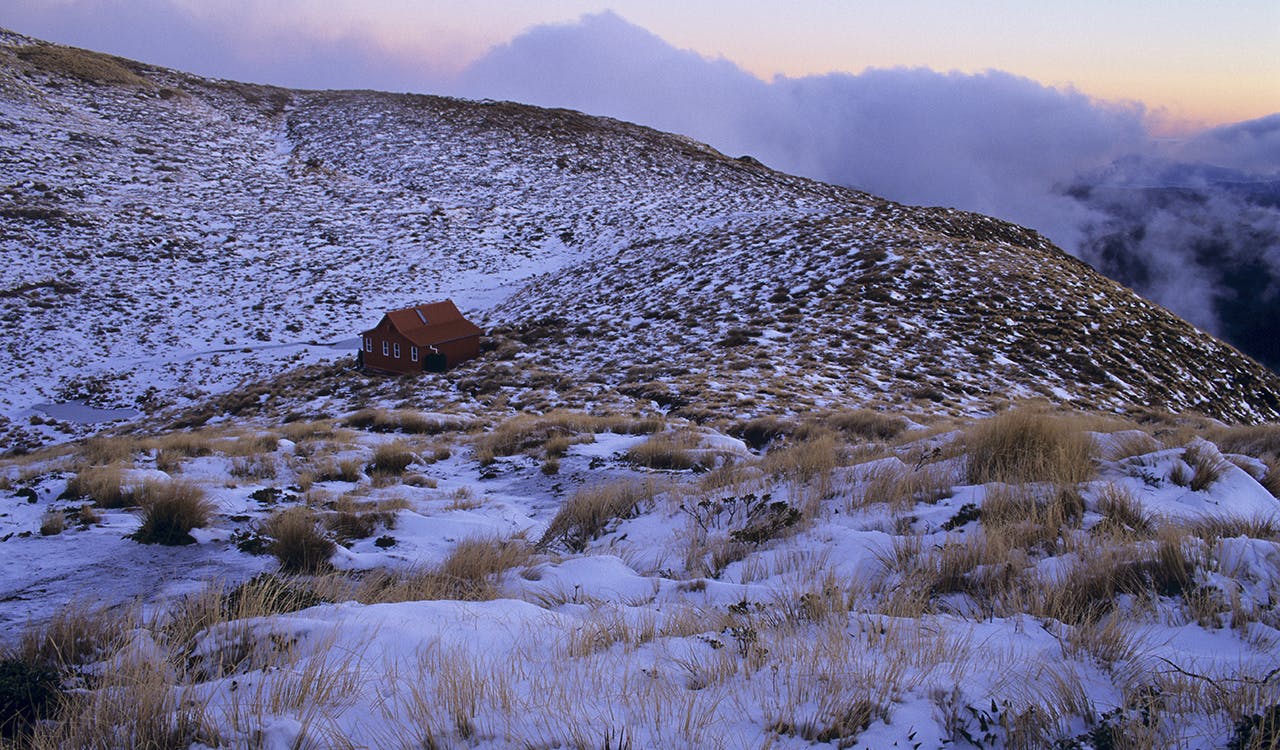
Dusk approaches at Kime Hut (Note, this hut is not the current version of Kime Hut). Photo: Shaun Barnett/Black Robin Photography
Winter tramping in the Tararuas can be a fickle beast. For those who are used to summer challenges in the ranges, a heavy winter snowfall can transform the range and open up a host of new adventures. The recently replaced Kime Hut on the western side of the range can make a great place for a weekend tramp, with lots of bum sliding options off nearby high points. For those with snow skills, Mt Hector is a great winter summit too, when the famous memorial cross is coated with its cold armour of rime ice. For those wanting to swing their legs for a few days, the Tararua crossings make for classic winter trips, but fresh snow can make for considerably slower travelling times and sometimes snowed-in huts.
I once made a mid-winter trip in heavy snow over the legendary Tararua Peaks. We spent our second night of the trip bivvied on the summit of Aokaparangi is perfect weather, but the following day it took 18 hours to walk out via Anderson Memorial Hut and the Waitewaiwai Valley. Such was the effect deep snow had on our travel.
Even without snow about, the Tararuas in winter take a different dimension when the tussocks are frosted white and the puddles frozen. You might have cold fingers, but you won’t sink as deeply into the frozen mud.
Access Otaki Forks (for Kime Hut/Mt Hector) Time 2-3 days
Lewis Pass National Reserve
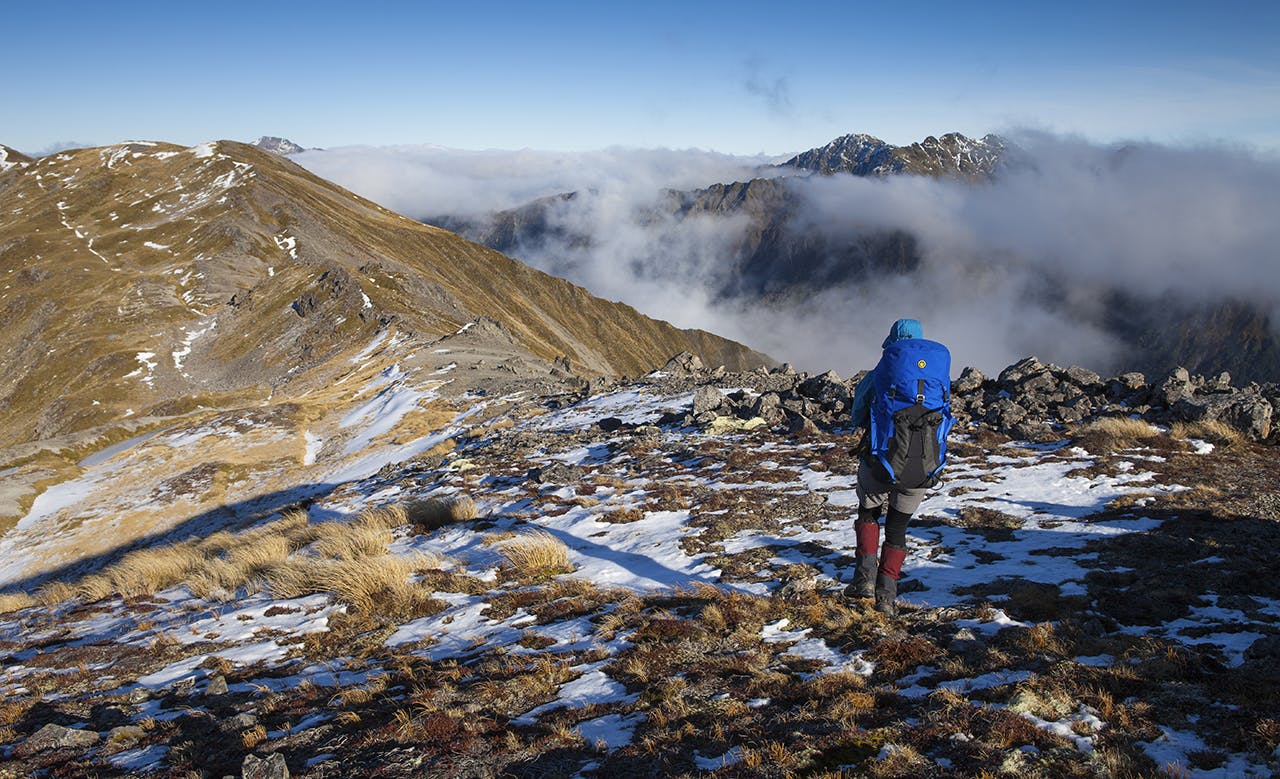
On the Zampa Tops, Lewis Pass National Reserve. Photo: Mark Watson
Easy access from Christchurch, nice valley tramping and quick access to the tops make Lewis Pass National Reserve a great place for winter weekend tramps, with some options for longer trips too.
Narnia-esque is how I’d describe the valleys in this area come mid-winter. If it’s a cold one, the valleys will be locked in silence, with frost coating the ferns, ice on the puddles and streams reduced to a trickle. It’s a special time to be there. While the valleys make for good short tramps, if you want to see some sun, the tops are the place to be. Basic snow craft skills are essential here, and if you can use ice axe and crampons a heap of options open up.
A great moderate weekend trip involves walking from the pass itself to Brass Monkey Bivouac via the Lewis Pass Tops and over the peaks Lucretia and The Apprentice (Mt Technical nearby is a good summit to bag, too). There’s great camping on rolling tussock benches nearby if the hut is full. The following day the tops are traversed further to the Rough Creek Track, which is descended to the Lewis Pass Highway, where a soak in the Maruia Hot Springs awaits.
Other options include the Zampa Tops (two days) which includes some more challenging off-track travel. Lake Christabel (2-3 days) and Mueller Tarn (1-2 days).
Access From Lewis Pass Highway (for Lewis Pass Tops, Zampa Tops and Mueller Tarn) Time 1-3 days
Aoraki/Mt Cook National Park
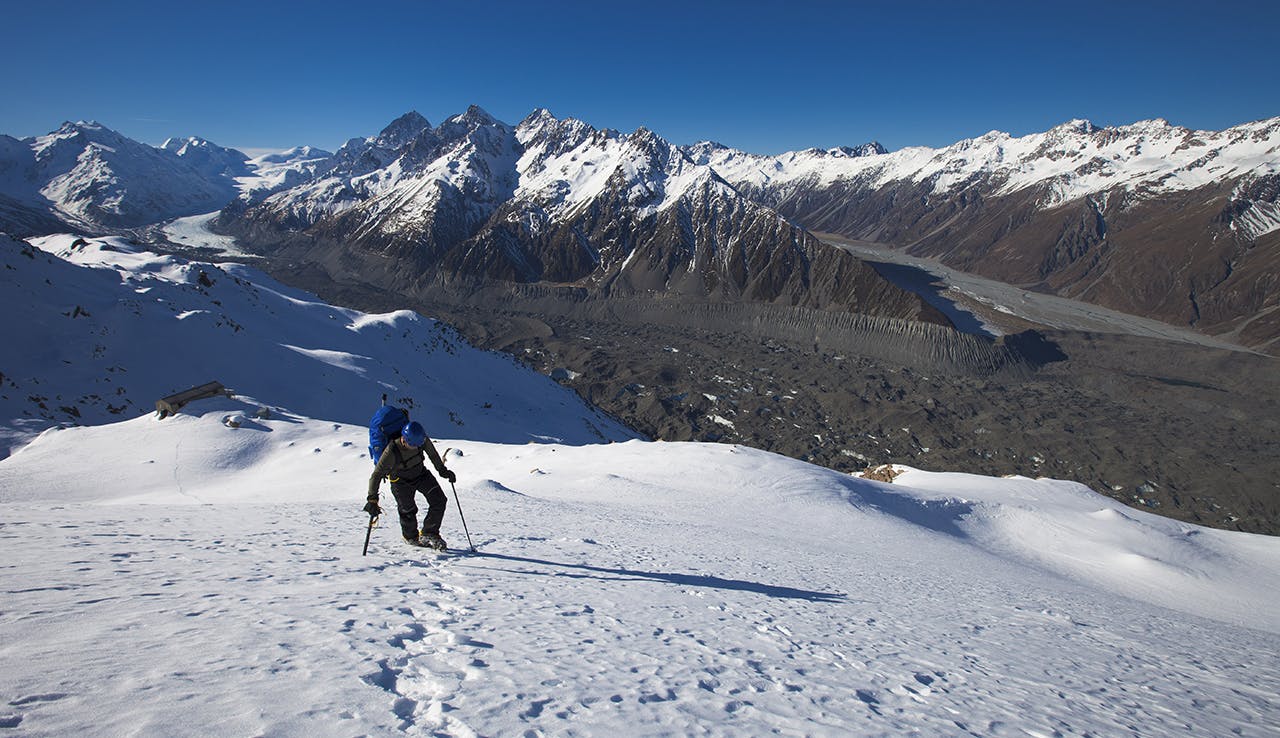
Climbing to Ball Pass, just above Caroline Hut, Tasman Glacier and Malte Brun Range in background. Photo: Mark Watson
The tincture of winter and often stable weather make Mt Cook an attractive winter tramping destination. While there are not abundant options for easy to moderate trips, the quality of two classic trips makes it well worth a visit.
Mueller Hut, now very popular on the backpacker circuit, is an excellent overnight trip and chances are you’ll have this awe-inspiring location to yourself. It’s around four hours to the hut from Mt Cook Village, the first half on a high quality track to Sealy Tarns, where there are great views of the Mueller Glacier terminal lake, and then the second half on easy (but unmarked) alpine terrain to the hut.
You’ll be treated to exceptional views of the Main Divide, Mt Sefton and Aoraki/Mt Cook, as well as East towards the Malte Brun and Liebig Ranges. The summit of Mt Ollivier, just behind the hut, makes a great vantage point.
The Ball Pass crossing, in whole or part, makes another top winter trip though avalanche risk can make this a more serious proposition. From the Tasman Valley you can follow an unmarked route from Ball Hut towards Caroline Hut (private, with emergency shelter) with abundant camping options to choose from. Axe and crampons are essential and if doing the full crossing alpine route-finding skills and avalanche awareness are essential. Basic avalanche rescue kit should be carried, along with at least one snow shovel. The walk will be rewarded with unimpeded views directly across to the 2000m tall Caroline Face of Mt Cook and up the Tasman Glacier towards De La Beche corner. It’s one of New Zealand’s most spectacular places.
Access Whitehorse Campground (for Mueller Hut), Ball Road terminus (for Caroline Hut/Ball Pass) Time 2-3 days
Mt Aspiring National Park
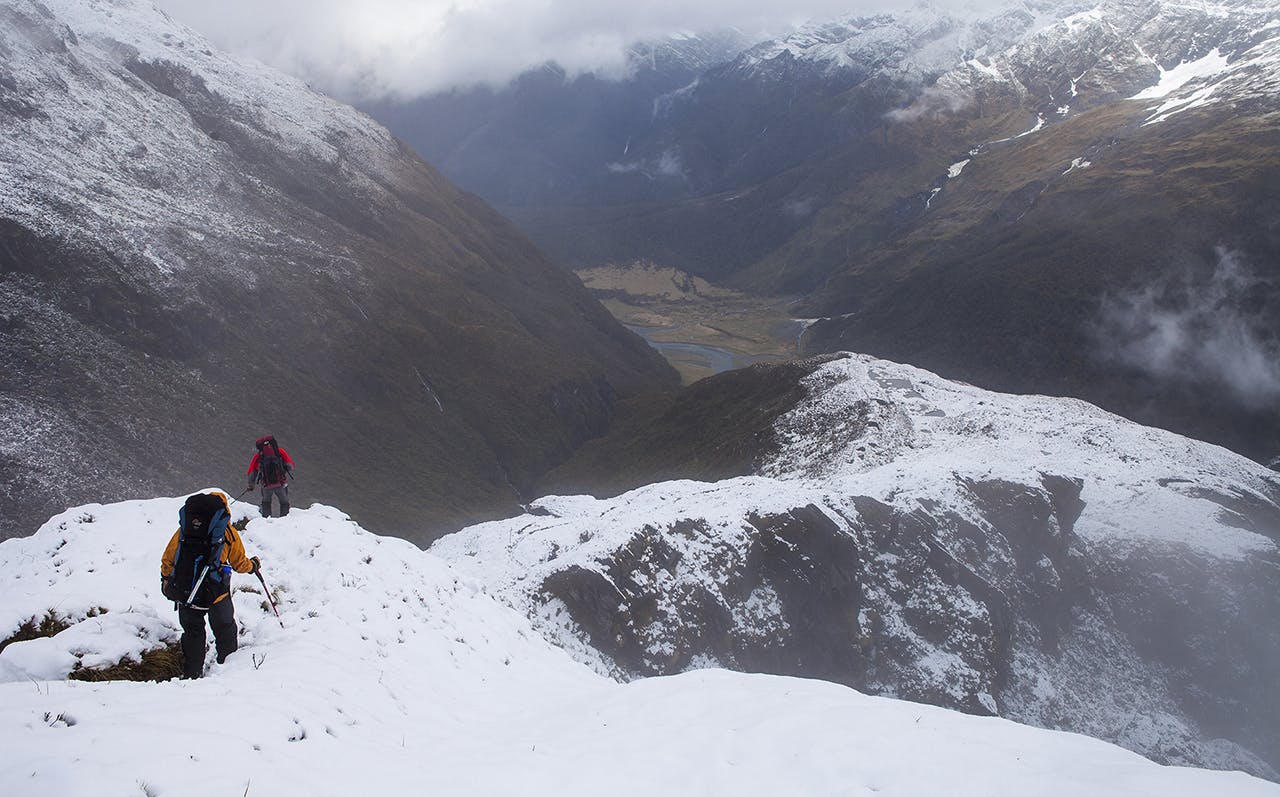
Descending French Ridge in fresh snow. Photo: Mark Watson
As an access point, the West Matukituki Valley provides multiple options for winter tramps, although snowfall and avalanche risk can limit these. Two fairly reliable options are French Ridge Hut and Liverpool Hut, perched on the flanks of the ranges either side of the Matukituki.
Both are reached from Aspiring Hut (2hr from road end), which can make a great destination in its own right if you are looking for an easy trip and some winter quiet.
Beyond Aspiring Hut it’s another 1.5hr to Pearl Flat, where you have the option of climbing steeply to either Liverpool Hut (2hr) or French Ridge Hut (3.5hr). Once you’ve negotiated the steep, beech forested climb to the bushline and thence Liverpool Hut there are stunning views of Mt French and the top of Mt Aspiring. Mt Tyndall is dominant to the south. The hut itself is nestled in an alpine basin surrounded by tussock and dracophyllum.
The longer climb to French Ridge Hut first entails a frigid (but shallow) river crossing. Your feet will soon warm as you tramp steeply through beech and then tussock slopes on one of the main access routes for Mt Aspiring. The hut’s on an exposed site and consequently the views of Mt Barff and Liverpool and Arawhata Saddle are spectacular, especially under their winter blanket. It’s a spot worth spending a couple of nights at.
Access Raspberry Flat, West Matukituki Valley Time 2-4 days
Hypothermia and frostbite
Winter in the mountains calls for a reconsideration of your alpine wardrobe.
If you’re going to be spending any time above the snowline in winter, an insulated jacket, softshell (or light breathable windproof), neck gaiter (or balaclava) and extra insulation for the legs are essential. These will augment typical outdoor clothing to help keep your core warm; the first line of defence against cold fingers and toes.
Low winter temperatures increase the risk of cold damage to extremities and while frostbite is rare at typical tramping elevations, it’s not uncommon among climbers. Staying hydrated is also essential.
If you do suspect cold damage, avoid use of the extremities; warm slowly and keep warm; cover with dressings and see a doctor as soon as possible.
Avalanche
All backcountry users heading beyond the snowline at any time of the year need to be aware of avalanche risk. Although New Zealand has a high proportion of summer avalanche incidents, the majority take place during winter and the majority of those that result in burial are self triggered.
The best place to get an overview of current avalanche risk for the mountains is www.avalanche.net.nz. This excellent advisory service also offers a range of courses including a basic ‘avalanche awareness’ course that is recommended for anyone venturing into the New Zealand backcountry, especially in winter.
For travel in avalanche prone areas, a transceiver, probe and shovel should be carried, along with the knowledge to use them.





